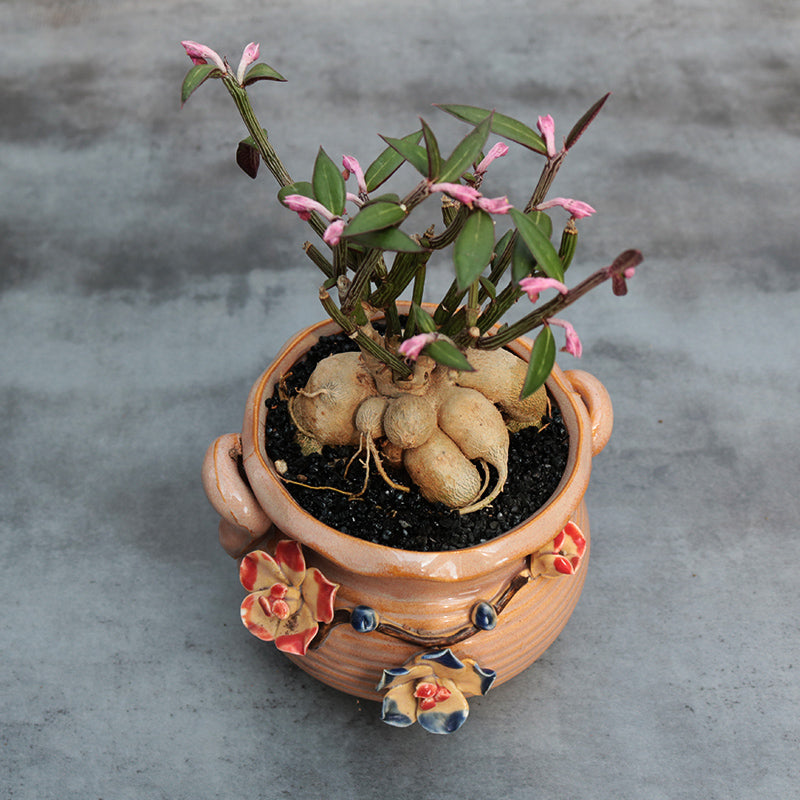Monadenium montanum var. rubellum is a succulent plant belonging to the Euphorbiaceae family and the Sansevieria genus. It is native to Africa and is also known as the high-mountain single-gland Sansevieria. The plant features a tuberous, light gray rhizome resembling ginseng, with round, fleshy stems at the top, which are longitudinally ridged. The leaves are thick, somewhat like a diamond shape, with a gray-green color on the front and purple-red on the back, with small flowers in deep pink.
Monadenium montanum var. rubellum is known as a "three-view" plant, referring to its flowers, leaves, and roots. In particular, the rhizome of Monadenium montanum var. rubellum can be compared to that of ginseng. It has a stem-like succulent flower. The stem base of the plant is swollen, spherical, or potato-shaped, resembling ginseng, with a gray-white to yellow-brown skin. It has fine, columnar stems at the top. Branches grow obliquely, with brown or green skin and gray-white longitudinal stripes. The leaves are elliptical, green with a purple hue on the front and purple-red on the back, with light green markings, arranged alternately. It blooms in summer and autumn, with small, pink flowers growing between the stems and leaves.
It prefers abundant sunlight and a warm, dry environment, tolerating drought but disliking dampness and cold, and tolerating partial shade. During the growing season, keep the soil moist without water accumulation. Apply diluted organic or compound fertilizer every 15 to 20 days. During dormancy, strictly control watering to prevent rhizome rot due to excessively wet soil, and stop fertilizing. Avoid prolonged exposure to rain during cultivation. Some shade may be provided in summer to prevent sunburn. Reduce watering in winter, maintaining a temperature of around 10°C. Repot every 2 to 3 years in loose, fertile, well-drained soil with good aeration and containing some lime to promote rhizome growth.
Monadenium montanum var. rubellum is a representative species of tuberous succulent plants. Its yellow-brown tuberous stem base is swollen, with a greenish-gray soft branch at the top, narrow green leaves arranged alternately, and peach-colored flowers at the branch tips. It has a delicate and exquisite appearance, with a quaint and unique charm. It can be compared to the elegant and charming "ginseng ficus" bonsai, and is highly favored by enthusiasts.
Propagation of stem succulent plants is mainly by sowing seeds, although some species can survive by cuttings, they often fail to form swollen stems, greatly reducing their ornamental value.
Seasonal Care:
Spring:
Propagation by cuttings: Select sturdy branches and cut them into 10-12 centimeter cuttings. Apply sulfur powder or wood ash to the cut surface, and insert it into the seedbed after the wound has dried. Keep it semi-shaded with moderate humidity, and it will root in 10-15 days.
Transplant newly rooted cuttings promptly, and old plants should be repotted every 2-3 years. It prefers loose, fertile, well-aerated soil with good drainage, which can be prepared by mixing peat soil, rice husk ash, river sand, and a small amount of lime. Loose soil helps the stem base swell. When planting, bury the stem base in the substrate to promote swelling.
Prefers sunlight, tolerates partial shade, and should be provided with adequate light.
Prefers dry conditions and tolerates drought. Watering should follow the principle of "alternating dryness and wetness with a bias towards dryness," keeping the soil moist but not waterlogged.
Apply diluted liquid fertilizer or compound fertilizer every 15-20 days, and additional potassium fertilizer can promote stem base swelling.
Summer:
Provide some shade to prevent sunburn.
Water according to the principle of "alternating dryness and wetness with a bias towards dryness," keeping the soil moist, avoiding excessive wetness and waterlogging, and preventing rainwater from accumulating to avoid rhizome rot.
Apply potassium-based fertilizer every 15-20 days.
Autumn:
Provide adequate sunlight and water according to the principle of "alternating dryness and wetness with a bias towards dryness."
Apply phosphorus and potassium-based fertilizer every 15-20 days.
Winter:
It cannot tolerate cold, so keep the winter temperature around 10°C.
Provide adequate sunlight, strictly control watering, and stop fertilizing.
